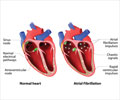- Amiodarone Related Skin Toxicity - The Blue Man Syndrome; a Case Report and Review of Literature - (https://pubmed.ncbi.nlm.nih.gov/35817158/)
- Amiodarone - Why is this medication prescribed? - (https://medlineplus.gov/druginfo/meds/a687009.html#why)
- Blue man syndrome - (https://www.cmaj.ca/content/188/8/604)
- Adverse reactions of Amiodarone - (https://pubmed.ncbi.nlm.nih.gov/31447894/)
What is Blue Man Syndrome?
Blue man syndrome is a condition that presents with bluish gray hyperpigmentation of the skin due to long term administration of amiodarone. This is a rare side effects of the drug amiodarone. It presents in 1%-3% of patients being treated with amiodarone. Usually, it tends to develop over the sun exposed areas of the body typically involving the face and neck(1✔ ✔Trusted Source
Amiodarone Related Skin Toxicity - The Blue Man Syndrome; a Case Report and Review of Literature
Go to source).
Causes of Blue Man Syndrome
Long term use amiodarone causes blue man syndrome. Amiodarone is used to treat and prevent certain types of serious, life-threatening ventricular arrhythmias (a certain type of abnormal heart rhythm) when other medications did not help or could not be tolerated. Amiodarone is in a class of medications called antiarrhythmics. It works by relaxing overactive heart muscles(2✔ ✔Trusted Source
Amiodarone - Why is this medication prescribed?
Go to source).
The discoloration could be due to amiodarone speeding up the natural, regulated cell mechanism that removes unnecessary or dysfunctional components (autophagocytosis), which leads to an increased production of lipofuscin (a pigment) that accumulates in lysosomes. Phototoxic damage could explain the distribution of the discoloration in sun-exposed areas. Alternatively, discoloration may be due to drug deposition within dermal cells in sun-exposed skin(3✔ ✔Trusted Source
Blue man syndrome
Go to source).
The exact reason why amiodarone causes the bluish discoloration of the skin is unclear. Several different theories have been hypothesized, including a drug induced metabolism disorder (lipidosis), a photosensitivity reaction to UV (ultraviolet) light, or skin hypersensitivity (leukocytoclastic vasculitis).
Men are more than twice likely to experience this adverse reaction compared to women. Currently, there are no studies which explain this.
Why is the Bluish Discoloration Present in Sun Exposed Areas?
It is suspected that UV light causes amiodarone and the end products of its metabolism (metabolites) to attach to the blood vessel walls and tissues. This is associated with local vasodilatation and increased distribution of amiodarone and its metabolites, resulting in chronic tissue accumulation. Thus, only unexposed regions of the body are affected.
Argyria and Methemoglobinemia can Cause Bluish Discoloration of Skin
Conditions like argyria and methemoglobinemia can also present with bluish discoloration of the skin.
Argyria is due to extended exposure to silver salts either through ingestion or contact. Toxic deposits can come from occupational, medicinal, or chemical exposure. Argyria presents with skin that’s bluish-silverish-grayish in complexion. This staining of the skin can also be seen in the conjunctiva of the eyes and other mucosal membrane areas.
Methemoglobinemia is due to the presence of iron in ferric form instead of the usual ferrous form, which, in turn, results in a decreased availability of oxygen to the tissues. This decrease in oxygen then causes a varying degree of bluish discoloration of skin. The condition can arise from a genetic defect or, more commonly, a condition acquired through exposure to certain medications and chemicals, such as benzocaine and xylocaine, carcinogen benzene and nitrites used as meat additives, or certain antibiotics, including dapsone and chloroquine. The exposure can occur through inhalation, ingestion, injection, or skin and mucous membrane exposure.
Diagnosis of Blue Man Syndrome
A complete medical history is taken. This includes the patient’s medication history and potential exposure to chemicals. Assessment for bluish discoloration of the skin, especially around areas of the skin exposed to the sun, such as the face and hands is carried out.
The physical exam should include an evaluation of signs of respiratory distress and impending respiratory failure such as accessory muscle use. Auscultation of lung sounds is also useful for ruling out asthma, pneumothorax, pneumonia, or congestive heart failure as causes of hypoxia. When a patient is on chronic amiodarone therapy, signs of toxicity, such as hyperthyroidism, lung injury or hepatic disease, should be investigated.

Treatment of Blue Man Syndrome
Although Blue man syndrome is not fatal, discontinuation or lowering of the amiodarone dosage is the main recommended treatment. However, this is dependent on whether the patient’s current clinical status can tolerate a decrease in therapeutic dosing or a substitute medication. Some patients have no alternative but to tolerate the adverse reaction until a change in their condition allows for a substitute therapy. After the diagnosis is confirmed, the reduction of discontinuation of amiodarone is done. It is also important to carefully observe for any cardiac dysrhythmias that may occur as a result of the adjustment.
Limiting sun exposure may also help. This can be done by using sunscreen, sunglasses and protective clothing. It might also help to avoid direct sunlight altogether. Cases have shown resolution of discoloration typically 1 year after discontinuation of amiodarone(4✔ ✔Trusted Source
Adverse reactions of Amiodarone
Go to source).







